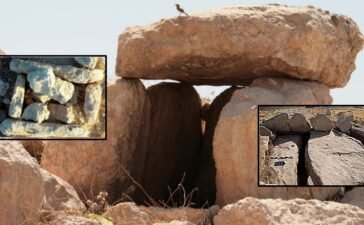Conny Waters – AncientPages.com – Numerous examples illustrate the profound fascination ancient civilizations held for the color blue. It was considered a divine color, associated with celestial deities believed to dwell in the heavens. Blue was revered as a sacred color.
The blue color is clearly visible on hieroglyphic carvings and paintings on the interior walls of ancient Egyptian temples. Credit: Adobe Stock – Kokhanchikov
In recent study reported in NPJ Heritage Science, researchers led by Washington State University (WSU) who collaborated with colleagues from the Carnegie Museum of Natural History and the Smithsonian’s Museum Conservation Institute, have recreated the world’s oldest synthetic pigment, known as Egyptian blue, which was used in ancient Egypt approximately 5,000 years ago.
The team utilized a range of raw materials and heating times to develop 12 recipes for the pigments, providing valuable information for archaeologists and conservation scientists studying ancient Egyptian materials.
Egyptian blue pigment, highly prized in ancient times, has left limited archaeological traces regarding its production methods. This pigment served as a substitute to costly minerals such as turquoise or lapis lazuli and was applied in painting on wood, stone, and a papier-mâché-like material known as cartonnage.
The color of Egyptian blue varied from deep blue to dull gray or green, influenced by its ingredients and processing duration. Following the Egyptians, the Romans also utilized this pigment; however, by the Renaissance era, much of the knowledge surrounding its creation had been lost.
An ancient wooden Egyptian falcon. Inset: A powder developed by WSU for research into Egyptian blue. (Composite featuring photos by Matt Unger and Joshua Franzos, Carnegie Museum of Natural History)
“We hope this will be a good case study in what science can bring to the study of our human past,” said John McCloy, first author on the paper and director of WSU’s School of Mechanical and Materials Engineering. “The work is meant to highlight how modern science reveals hidden stories in ancient Egyptian objects.”
Recently, interest in the pigment has resurged due to its optical, magnetic, and biological properties with potential technological applications. It emits light in the near-infrared spectrum, useful for fingerprinting and counterfeit-proof inks, and shares chemistry with high-temperature superconductors, according to McCloy.
Therefore, to understandthe pigment’s makeup, the researchers created 12 different recipes of the pigment from mixtures of silicon dioxide, copper, calcium, and sodium carbonate.
Examples of Egyptian blue pigment used on ancient artifacts. Photos by Carnegie Museum of Natural History
They heated the material at approximately 1,000 degrees Celsius for between one and 11 hours to replicate the temperatures that would have been available to ancient artists. After cooling the samples at various rates, they studied the pigments using modern microscopy and analysis techniques that had not been previously employed in this type of research, comparing them to two ancient Egyptian artifacts.
Egyptian blue included a variety of blue colors, depending on where they were made and its quality.
The researchers found that the pigment is highly heterogeneous. Additionally, the team found that to get the bluest color required only about 50% of the blue-colored components.
However, it doesn’t matter what the rest of it is, which was quite surprising to us. You can see that every single pigment particle has a bunch of stuff in it — it’s not uniform by any means,” said McCloy.
At present, the samples produced are exhibited at the Carnegie Museum of Natural History in Pittsburgh, Pennsylvania. Subsequently, they will be part of the museum’s forthcoming long-term gallery dedicated to ancient Egypt.
Written by Conny Waters – AncientPages.com Staff Writer
You Might Also Like
Ancient Secrets Of The Lost Megalithic City Of Nhambiquaras In The Amazon Jungle
Ellen Lloyd - AncientPages.com - In recent years, the discovery of ancient cities hidden within the Amazon Jungle has been...
5,500-Year-Old Ceremonial Site Of Murayghat Discovered in Jordan
Conny Waters - AncientPages.com - A research team from the University of Copenhagen has made a significant discovery at Murayghat...
Fascinating Ancient Artifact Discovered In Georgia Confirms Native American Legend Of A Great Catastrophe And Contact With Pre-Columbian Visitors
Ellen Lloyd - AncientPages.com - The accidental discovery of a fascinating and rare ancient artifact in Georgia, North America, invites...
Archaeologists Uncover A 20,000-Year-Old Secret That Rewrites The Ancient History Of North America Forever
Ellen Lloyd - AncientPages.com - The ancient history of North America is more thrilling than ever, urging us to reconsider...













